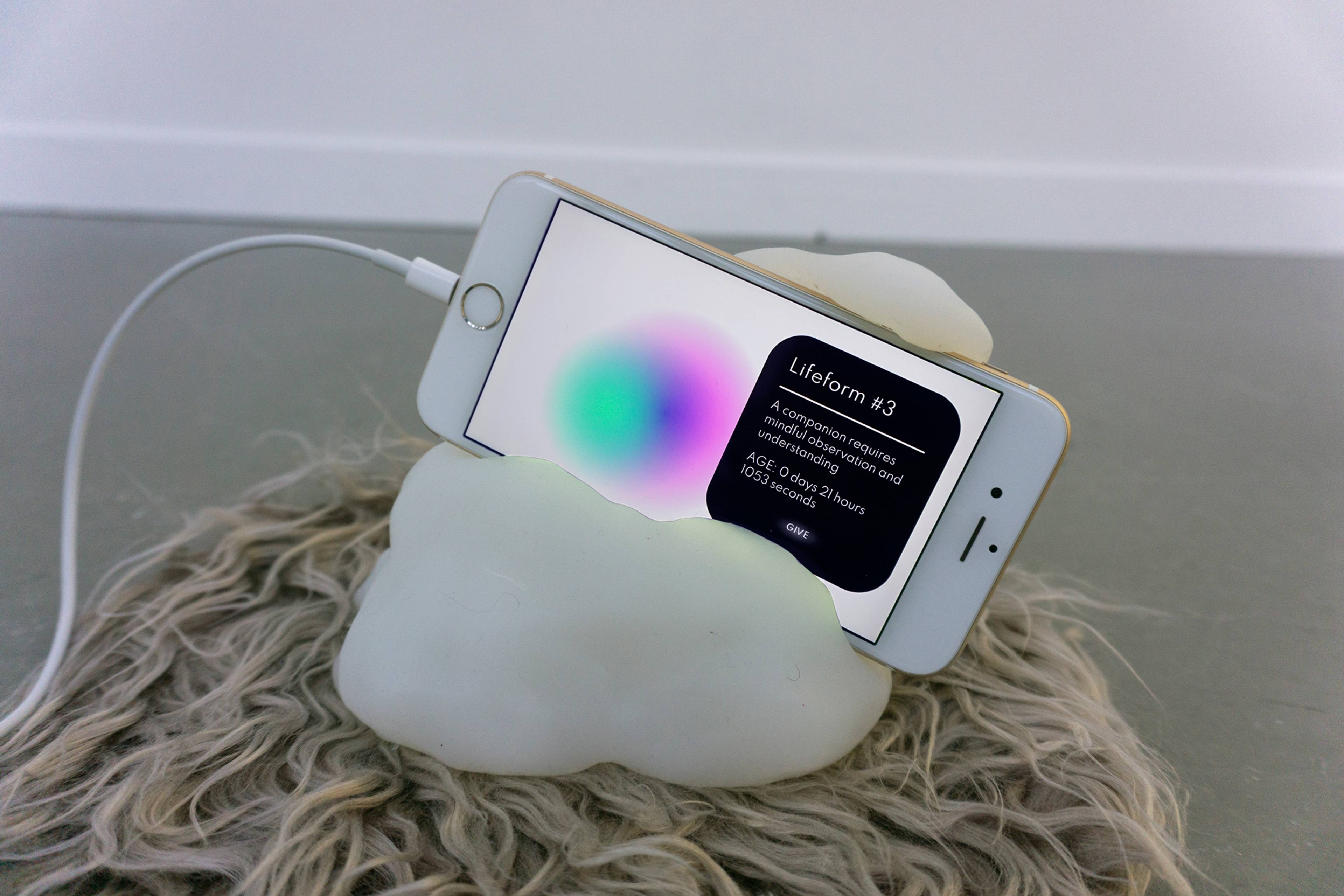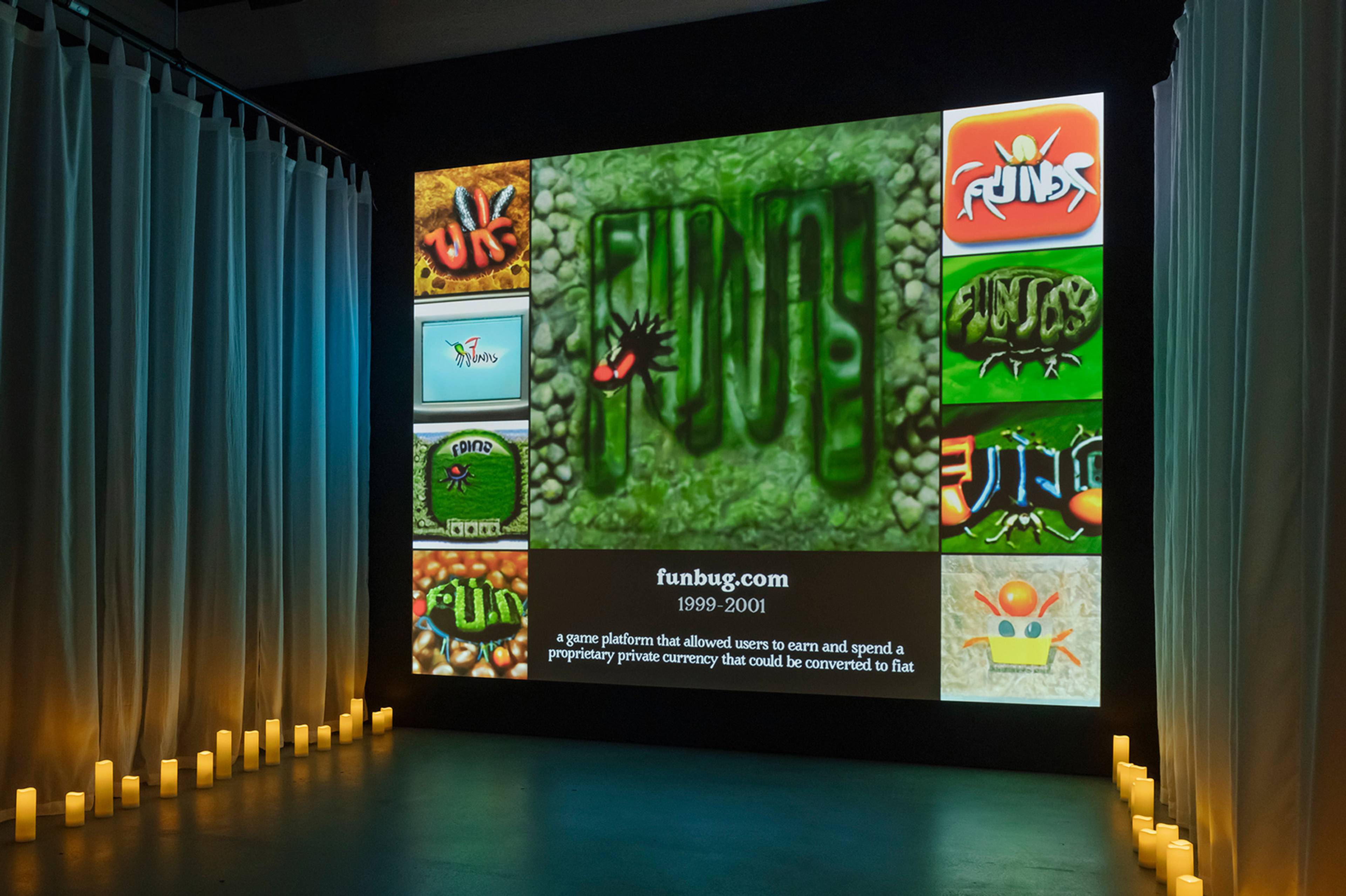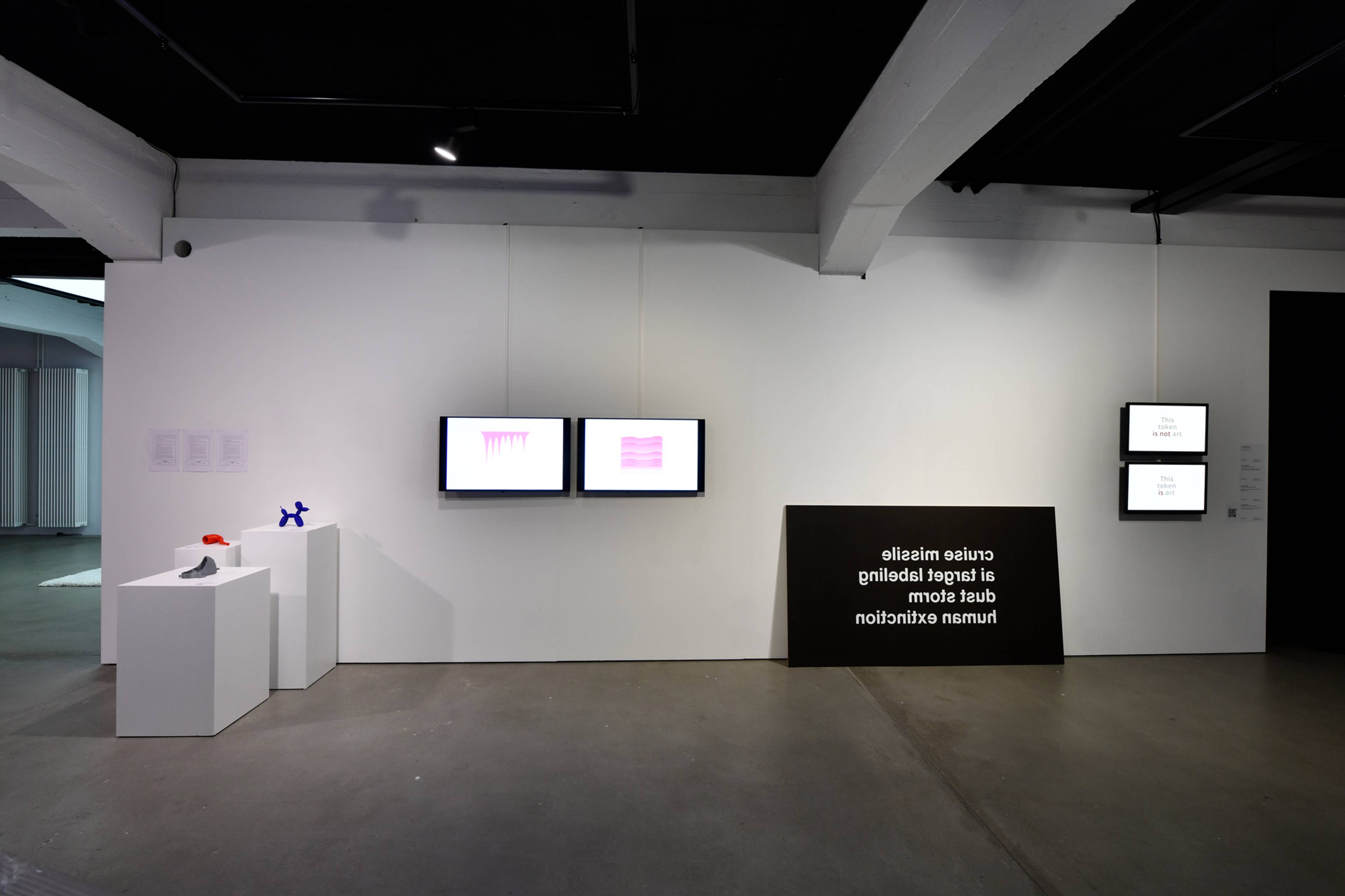At an end-of-summer outdoor rave in the neo-Brutalist complex housing Basel’s House of Electronic Arts (HEK), a large LED screen behind the DJ displayed DOM1 (2023), a glitchy generative NFT work by Leander Herzog and Milian Mori referencing a foundational web-based API, Document Object Model. Feeling like a virtual asset in a type of Swiss socialist architectural pitch for post-industrial revitalization, the rest of the nearly empty complex evoked the atmosphere of today’s metaverse and the COVID-era parties that once proliferated in its spaces. Inside, the exhibition “Exploring the Decentralized Web – Art on the Blockchain” extended the logics established in HEK’s foregoing exhibition on metaverse worldbuilding and continued the institution’s journey into strains of techgnosis.
Visitors to the darkened exhibition are greeted by Constant Dullaart’s Aura.lol (2022), a monitor haphazardly placed face-down on a photocopier that, with each press of a large red button, ejects piecemeal, monochromatic copies of Dullaart’s generative and transactional manifesto – an evolving text consisting of 256 manifestos available to mint on the Ethereum blockchain. The monitor’s unseen image is distorted as it spills onto the floor, the scene reminiscent of an office-based rapture. A smaller, adjacent monitor flashes images of frenetic, stuttering emojis overlayed with auspicious workplace mantras such as “cognition,” “dedication,” and “anticipation.” The button reminds me of the mid-aughts “Easy” button from the ad campaigns of the office-supply store Staples, which could miraculously solve any workplace crisis (and, later, any of life’s problems) with one, simple press – here mimicking some of Web3 and the blockchain’s more audacious promises of tangible, automatized solutions.
Simon Denny, Guile Twardowski, and Cosmographia, Dotcom Séance, 2021–22. Installation view, HEK, Basel, 2023. Courtesy: the artist and HEK Basel. Photo: Franz Wamhof
The fever dream of technological potential and the economic infractions at the height of the Web 1.0 are spiritualized and resurrected in Web3 as Dotcom Séance (2022), an installation by Simon Denny, Guile Twardowski, and Cosmographia. The companies of that era ascended in economic euphoria only to plummet into oblivion, either because of financial mismanagement rooted in techno-potentialist delusions, or the logistical hurdles of transcending the virtualized logic of network effects – but the residue of their aspirations lingers on. Serving as a historiographic touchpoint, they act as a locus for understanding the past as prologue for our current entanglement with Web3 and blockchain technologies.
Rhea Myers’s Certificate of Inauthenticity (2020), meanwhile, challenges the notion of NFTs as means of ascertaining authenticity and scarcity, creating contractual conditions for scale 3D models she commissioned of works from seminal artists using an open license. Myers utilizes blockchain-based smart contracts to ironically assert that the works are neither authentic nor created by her, drawing parallels to the certificate-based Conceptual art of Donald Judd or Sol Lewitt, including the potential future legal challenges posed by authentication and de-authentication. Were one to violate the conditions Myers has set, it remains uncertain who would enforce them.
View of “Exploring the Decentralized Web – Art on the Blockchain,” House of Electronic Arts, Basel, 2023. Courtesy: HEK Basel. Photo: Franz Wamhof
Rhea Myers, Certificate of Inauthenticity, 2020. Installation view, HEK, Basel, 2023. Courtesy: the artist and HEK Basel. Photo: Franz Wamhof
Speculative enforcement matrixes continue in Sarah Friend’s Lifeforms (2021–), exalting these conditions to “life” itself as a series of NFTs: pulsating, chromatic blobs that perish unless transferred or exchanged. Purchasing a Lifeform means adhering to its conditions or facing its demise, serving as spiritual offerings that sustain the belief these systems require to maintain authority – encoding the human spirit in its own image.
This image is intuitively carried over in Amanda E. Metzger’s Ever (2023), which uses the LLM GPT-3 to generate diary entries projected on the ceiling in an infinite scroll. The artist’s intimate art-school journal becomes fodder for reinterpretation by AI – reshaping her identity and offering buyers a future narrative born from melancholic introspection. Her apparently pseudonymous artist’s name supplants her occupational identity as a scientist, actualizing a cyclical theme of privacy, vulnerability, and compartmentalization in her practice. Curiously, it’s a moniker shared with Gustav Metzger, who coined the term “auto-destructive art” in the 1960s.
When Web3 and decentralized tech-art interfaces clash with more traditional presentation formats, we find ourselves grappling with the mediums’ tangibility and speed. Even their essence lies in the immaterial expanse of nuanced network gestures, their embodiment takes precedence, the observation of which is not unlike viewing live-performance documentation. This pause, inherent to the de-virtualization process, highlights the lag in material updates, contrasting sharply with rapid evolutions in the digital realm. Such sentiment echoes through the space: In Chloe Michel’s installation and Kyle McDonald’s work, archived posts about Bitcoin usurping all forms of currency; Ethereum’s energy consumption; and NFT-market carbon reparations, once foci of crypto discourse, now seem like relics from a distant era. The swiftness of transformation is also evident in other works’ aesthetics: Dotcom Séance and some of the images by Botto, for instance, are emblematic of a specific era of image production using generative adversarial networks. These works symbolize an overlooked critique of AI systems: that our emphasis on form often sidelines foundational intent.
Throughout the exhibition, there’s a certain skepticism toward the lofty ideals of decentralization that surfaces when viewing art linked to blockchain and AI. The challenge is often one of reconciling the immaterial nature of these works with traditional exhibitory models. Here, the essence of the art is not merely visual; it’s predominantly its foundational code, a reminder of the nuances that give this genre its definition. Wandering aimlessly through Basel later, transactional promises on my mind, a sign for CrossFit gyms catches my eye: “If you don’t like the results, you can have your old body back” – an institutional equivalent of the medium’s own paradoxical “Easy” button.
Chloé Michel, Proof of Faith, 2022. Installation view, HEK, Basel, 2023. Courtesy: the artist and HEK Basel. Photo: Franz Wamhof
“Exploring the Decentralized Web – Art on the Blockchain”
House of Electronic Arts, Basel
2 Sep – 12 Nov 2023






